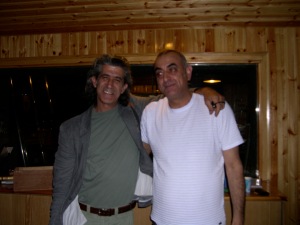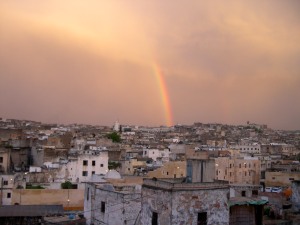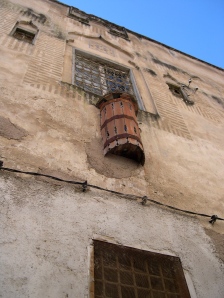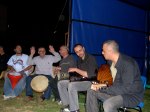
Issa Feij, Said Murad
In a conversation with musician Said Murad and his dear friend Issa Feij, a photographer and documentary filmmaker, it was suggested that the Israeli/Palestinian divide was akin to looking at each other like animals in the zoo. “Yes,” Said responded, “but we’re animals
outside the zoo.” So the bars are up, but it’s being outside of them that’s captivity. Or is it? Do the barriers keep others out or trap those within?
Issa, a Palestinian who grew up in the Old City back when there were no settlements there (now there are three in his parents’ neighborhood), has a different kind of wall, an emotional one that he erects himself, a wall of deflection, in order to preserve his spirit. “I don’t want to think about what I lost. I try to avoid the bad things happening in Jerusalem,” he said cheerfully, but with a weary sadness around his eyes, one lanky leg entwined around the other. “I look somewhere else—it could be music, it could be writing.” When asked if he has Jewish friends, he said, “of course,” and mentioned that he once had an Israeli girlfriend. “It wasn’t about politics,” he stressed, “it was about us.”

Amal Alqasem
Contrastingly, Amal Alqasem, president of the Women’s Forum of Sheikh Jarrah, activist for Palestinian rights, Bulgarian-educated economics professor, mother of four who walks tall in her pointy-toed, high-heeled shoes, has no such wall of avoidance—unable to look somewhere else, because the wall of conflict is too concrete. She meets it head-on daily in her fractured neighborhood, where Israelis claiming that the land is rightfully theirs evict Palestinian families, who then live in tents directly outside their former homes—in their adversaries’ faces, no actual wall separating them while the metaphorical wall looms large—as “a symbol of residence, refusing the decision of the Israeli government.” Her organization offers Palestinian women legal advice, courses in administrative planning and current politics, media training—to “support the personality of the woman.”
 Amal’s house, where she was born in 1960, where a bomb exploded seven years later, where both her parents died, and where eviction could come at any moment, is, simply and crucially, “my home.” And Jerusalem is her home. But since the second Intifada of 2000-2001, it hasn’t been the home of her husband, a Ramallah native who is therefore forbidden to reside in Jerusalem. They could live as a family in Ramallah, but for reasons both practical (schools, health care, identification card) and of principle, Amal makes the personal sacrifice of living apart, with weekend visits, in order to maintain her claim to Jerusalem. “I was born here. I played here,” she insists, her voice accelerating angrily, the embroidered Palestinian flag pendant around her neck bouncing. “But now, we are under occupation, from head to leg. It is not a life.”
Amal’s house, where she was born in 1960, where a bomb exploded seven years later, where both her parents died, and where eviction could come at any moment, is, simply and crucially, “my home.” And Jerusalem is her home. But since the second Intifada of 2000-2001, it hasn’t been the home of her husband, a Ramallah native who is therefore forbidden to reside in Jerusalem. They could live as a family in Ramallah, but for reasons both practical (schools, health care, identification card) and of principle, Amal makes the personal sacrifice of living apart, with weekend visits, in order to maintain her claim to Jerusalem. “I was born here. I played here,” she insists, her voice accelerating angrily, the embroidered Palestinian flag pendant around her neck bouncing. “But now, we are under occupation, from head to leg. It is not a life.”
Walking distance but a world away from Sheikh Jarrah is the Museum on the Seam. The “socio-political contemporary art museum” is currently featuring “HomeLess Home,” showcasing the work of artists—photographers, sculptors, videographers—from all over the world, including Israel and Palestine. The piece that most struck me was Israeli videographer Guli Silberstein’s “Excerpt,” a clip from a news segment, slowed down and magnified, of a Palestinian family just evicted from their home, seeking shelter behind a wall—this time an actual rather than a metaphysical wall, to protect not just the spirit, but the body, as well—in their street-turned-battlefield. Hauntingly, and to the distorted tune of gunfire, we see a young boy running toward the camera and first smiling as he’s swept up into his father’s arms, then beginning to scream—slowly, silently—as his father tenderly covers his mouth.

Museum on the Seam
Curator Raphie Etgar invited 20 Palestinian artists to participate in the exhibition but just five are, and on the condition that the museum obtain their work through indirect means—local work was sold and shipped to European collectors, only to be bought and transported back, in a sort of art laundering maneuver—for fear of being ostracized by their Palestinian artist communities. But I wonder if the artists who declined the invitation shared that with their communities, to point out both the prestige of the invitation and their sense of honor in declining it? What does Issa, for instance, think of the Museum on the Seam, and would he have participated? (I’ve asked, and will post an update.) The museum got its name from sitting right on the dividing line between the two Jerusalems. But doesn’t a seam, unlike bars of a cage or a wall, connect disparate pieces—as with fabric—rather than dividing them?
Postscript: At a dinner party in Ramallah—a word, I’ve noticed, said always with a strong, lingering emphasis on the second syllable, the “L” suspended as the tip of the tongue caresses the palate—I looked around and realized that everyone present, except for three of us visiting from the U.S. and Canada, was a man. Where are the women? I wondered. I thought of Amal, her fortitude and courage, her desire for her younger daughter, ten-year-old Aliza—named after the determined queen of Tunis—to be a doctor. I thought of Amal’s fire. After dinner, stopped at the checkpoint back into Jerusalem, we encountered a different sort of woman: a girl, really, still in her teens, pretty and fresh. Her high ponytail of sleek brown hair swayed as she strolled up to our car, her eyes bright, her air casual, even playful. She glanced over our passports, passed them back through the window, smirked, and sauntered away, permitting us entry into the Holy City. A normal girl, except for the fatigues sitting low on slim hips and the M-16 diagonally strapped across her narrow frame. Nazmi Ju’beh’s checkpoint story came to mind, him pitying the soldier standing in the rain outside his car. Was this pretty, gun-slinging teenager in power? Keeping others out, or keeping herself captive? “When you feel safe,” Said had observed, “you’re open. When you feel threatened, you’re closed.”

Amal's daughter Aliza in front of a Palestinian house post-eviction


















